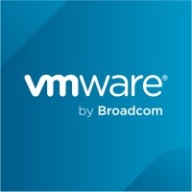

Find out what your peers are saying about Datadog, ServiceNow, Dynatrace and others in AIOps.
We can say 10% is the approximate amount of savings because most of the things are automated and streamlined, so the manual work is eliminated in most cases.
Recently, support has been less friendly and slower, especially after the company was acquired by Broadcom.
The quality of support should be improved; overall quality.
If we have issues, the support tends to be unreliable
Scaling is easy, whether it is hyperconverged or a three-tier architecture.
It is a highly scalable solution.
VMware vSphere is highly scalable in terms of the number of users and the number of servers it can handle.
While they are generally stable, if outages occur, they tend to be due to brands like HP or Dell, not VMware vSphere itself.
It is a very stable hypervisor solution.
Mostly we don't have issues, but sometimes we have faced some stability issues because of some bugs and some CPU compatibility issues with Intel CPUs.
Although the product is very strong and includes all necessary features, the high pricing drives many customers to avoid using it.
VMware vSphere has a built-in feature called Fault Tolerance, but it's very limited for very limited VMs or very limited core count or CPU count, so it's not so useful for all the environment because of the limitations.
Sometimes, it is difficult to find documentation for specific tools and solutions.
Many customers are trying to avoid it due to its high cost.
Costs significantly increased from perpetual to subscription, with prices rising by two to three times over three to five years.
The solution is too expensive.
The vMotion feature is beneficial for online migration of virtual machines from one host to another without downtime.
I always use VMware vSphere vMotion; we work with this feature all the time. vMotion is very useful; that's why we use the virtualization.
The tool is highly available, which is crucial for implementing critical applications requiring 24/7 availability.
| Product | Market Share (%) |
|---|---|
| IBM Turbonomic | 0.7% |
| Dynatrace | 19.9% |
| Datadog | 16.9% |
| Other | 62.5% |
| Product | Market Share (%) |
|---|---|
| VMware vSphere | 17.0% |
| Hyper-V | 15.6% |
| Proxmox VE | 15.5% |
| Other | 51.9% |


| Company Size | Count |
|---|---|
| Small Business | 41 |
| Midsize Enterprise | 57 |
| Large Enterprise | 147 |
| Company Size | Count |
|---|---|
| Small Business | 174 |
| Midsize Enterprise | 137 |
| Large Enterprise | 256 |
IBM Turbonomic offers automation, planning, and right-sizing recommendations to streamline resource management, improve efficiencies, and optimize costs across virtualized environments and cloud platforms.
IBM Turbonomic is valued for its capability to optimize resource allocation and monitor virtual environments efficiently. It facilitates automated decision-making in VM sizing, load balancing, and cost optimization for both on-premises and cloud deployments. Users can leverage insights for workload placement, ensure peak performance assurance, and effectively right-size across VMware and Azure. The ongoing transition to HTML5 aims to improve visual and navigational ease, while expanded reporting features are anticipated. Opportunities for improved training, documentation, and integrations enhance platform usability and functionality.
What Are the Key Features?In finance, IBM Turbonomic aids in maintaining platform efficiency during market fluctuations. Healthcare organizations leverage its capability for resource optimization during high-demand periods to enhance patient care support. Retailers use it for planning in peak seasons, ensuring resources align with fluctuating demand to maintain performance continuity.
VMware vSphere is a versatile virtualization platform known for its ease of use, flexibility, and high availability. It supports seamless migration, optimal resource allocation, and centralized management, making it highly suitable for diverse infrastructure needs.
VMware vSphere is widely adopted for its virtualization capabilities that enhance hardware efficiency and ensure minimal downtime through features like High Availability and Distributed Resource Scheduler. Despite criticisms about high licensing costs and limited fault tolerance, it remains a preferred choice due to its stability, scalability, and robust integration options. Users appreciate its efficiency in managing virtual machines and hosting enterprise applications, although challenges with web client performance and hardware compatibility are noted. Organizations often look for better integration with cloud services and enhanced automation and scalability.
What are the core features of VMware vSphere?
What benefits and ROI can businesses look for?
VMware vSphere is implemented across sectors like healthcare, finance, and education for server virtualization, data center management, and private cloud creation. Its use in facilitating business-critical operations ensures high availability and efficient resource use, supporting both development and production environments.
We monitor all AIOps reviews to prevent fraudulent reviews and keep review quality high. We do not post reviews by company employees or direct competitors. We validate each review for authenticity via cross-reference with LinkedIn, and personal follow-up with the reviewer when necessary.